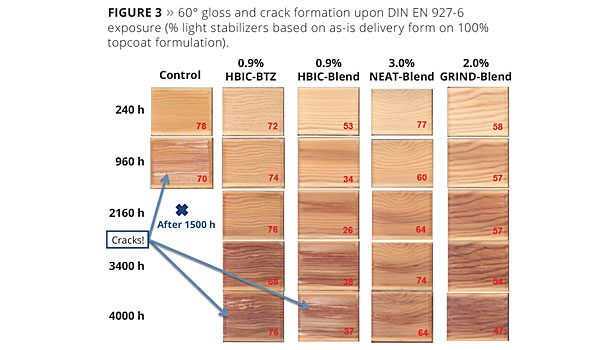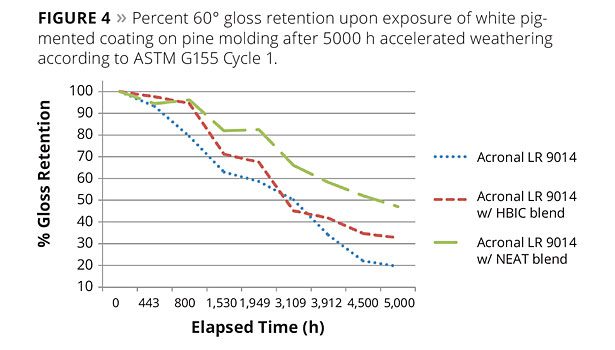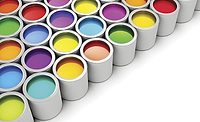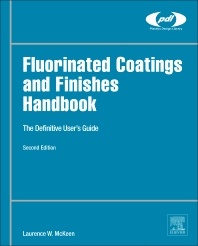Waterborne UVA/HALS Blend
for High-Performance Clear and Pigmented Coatings












Changes in legislation and the reduction of VOCs have enabled the emergence of waterborne coatings for numerous indoor wood coating applications like furniture and parquetry, as well as outdoor applications like joinery, exterior deco or decking. In order to emphasize the natural beauty and the color of the wooden substrates, most coatings are transparent. These coatings have to protect the wood, however, the coatings themselves need to be protected against aggressive environmental factors like UV radiation, rain and change in temperature.1 Light stabilizers such as UV absorbers (UVAs) and hindered amine light stabilizers (HALS) play an important role in the inherent protection of these coatings. Their respective roles have been described previously.2-4 For outdoor applications, there is a clear advantage to combining UVA and HALS. UV absorbers perform as deep coating layers and wood protectors, due to the increasing UV absorbance with increasing coating thickness (Beer-Lambert law). HALS, which are effective in the whole film thickness, act as free radical scavengers that inhibit the photo-oxidative reactions that occur within the binder matrix and help maintain flexibility, gloss and water repellency. HALS are effective at coating surfaces, providing higher chalking resistance (in pigmented systems), better gloss retention, less loss of adhesion to the substrate and less crack formation.
As long as coatings were still solvent-based, there were no issues incorporating the hydrophobic light stabilizers into formulations, as both were compatible with each other. The challenge came as more and more waterborne coatings were introduced to the market and long-term stability requirements became even higher. Incorporating the hydrophobic light stabilizers into waterborne coatings could only be achieved through the use of co-solvents and high-energy dispersing methods. Addition of co-solvents leads to possible labeling issues, as well as a lowering of the overall coating properties due to plasticization and exudation.
Novel Encapsulated Additives Technology
To overcome the issue of incorporating hydrophobic stabilizers into waterborne formulations, Novel Encapsulated Additives Technology (NEAT) was developed.5 With this technique, conventional hydrophobic light stabilizers are made water-compatible and can easily be post-added in coatings formulations without the use of co-solvents or surfactants.6 The NEAT approach is based on a mini encapsulation technique, wherein the preparation of these products requires two steps. First, stable emulsions comprised of light stabilizers and monomers are produced by high-shear emulsification techniques; droplet sizes are below one micron. In a second step, polymerization of these emulsions droplets leads to fine, low-viscous and stable aqueous dispersions.6-7 Polymerization conditions are chosen to ensure the hydrophobic compound is homogeneously distributed in the polymer particles. This NEAT approach ensures the broad compatibility with waterborne dispersions, even at higher concentrations.
First NEAT UVA/HALS Blend
NEAT products of single components (UVA and HALS) have been launched over the last few years (Table 1). NEAT forms of benzotriazole UVA (NEAT-BTZ), triazine UVA (NEAT-TZT-1 (blue-shifted), NEAT-TZT-2 (red-shifted) and NEAT-TZT-3 (advanced) as well as of HALS (NEAT-HALS) have found their place in various applications. Because of their limited active content (20-30% in product delivery form) the simultaneous combination of NEAT-UVA and NEAT-HALS may lead to an unintended additional amount of water that forces the customer to adjust the coating formulation. To overcome this problem, a novel blend based on NEAT technology was developed. This new product (NEAT-Blend) is based on the combination of a high-performance triazine UVA with a non-reacting HALS. The active content of this blend has been optimized (40%) to ensure the lowest impact on reformulation as possible.
The new blend has a low viscosity that allows its addition into a waterborne formulation by simple stir-in. It does not contain any co-solvent, which makes the formulation of Xi/R43 label-free coatings possible. The addition of this new product has no influence on the long-term shelf stability of the formulation.
Transparency and Color of Dry Films
One of the most interesting features of the NEAT-Blend is its very low impact on the transparency and the haze of dry films. Table 2 shows the values of haze, DE* (over black/white cardboard) and YI obtained with a glossy topcoat based on an acrylic dispersion, with and without light stabilizers.
With the addition of a hydrophobic benzotriazole (HBIC-BTZ), all values of haze, DE* and YI are very close to the reference values of the non-stabilized film.
The ground aqueous UVA/HALS blend (GRIND-Blend) shows a significant increase in DE*, indicating a strong haze. The haze is strongly dependent on particle size and distribution. The use of this type of product is thus limited to glossy and high-transparent coatings.
Increasing concentrations of NEAT-Blend show a very limited increase of haze and DE* compared to the reference. This new product can be easily used for glossy topcoats and a fortiorifor semigloss systems as well. The small increase in YI observed may limit the use of the NEAT-Blend on very white substrates. For wooden substrates, the higher YI is negligible.
Photopermanence
To ensure long-term protection of the coating and of the underlying substrate, it is essential that the UV absorbers have outstanding photopermanence (i.e., lightfastness), excellent inherent photostability (i.e., resistance to photolysis and photooxidation), as well as high resistance to migration and leaching.
Photopermanence tests were performed in an Atlas Xenotest 1200-LM device, according to the DIN EN ISO 11341 Procedure 1 Cycle-No A (2004). Test conditions: inner and outer filters, 102 min light, BST: 65 ± 3 °C, PRT: 38 ± 3 °C, relative humidity: 50 ± 10%, followed by 18 min light and front spray, BST: 38 ± 3 °C, PRT: 38 ± 3 °C, relative humidity 95 ± 10%. Output of the Xenon lamp is 60 W/cm2 between 300 to 400 nm.
Films of waterborne coatings with light stabilizers were applied on glass plates with a DFT of 30 microns. The remaining UV absorber level upon exposure time was monitored by recording the change in the absorption spectra at lmax. Results are shown in Figure 1.
The weakest UV absorber retention was clearly obtained with HBIC-BTZ, where only 45% of the original concentration remains in the coating after 3000 h of DIN EN ISO 11341 exposure. Since GRIND-Blend is composed of a benzotriazole UVA, it was expected that its photopermanence would be in the same order of magnitude as HBIC?BTC (50% compared to 45%).
The best results were obtained with NEAT-Blend, where the UVA retention after 3000 h of exposure is comprised between 80 and 90% for all three concentrations. The photostability of the UVA in the new blend is much better than the previous samples. With such a superior photostability combined with an excellent leaching resistance, the NEAT-Blend is the product of choice for long-term protection requirements.
Color Stabilization and Gloss Retention
The waterborne coatings were applied on pine. The back side and edges of the wooden substrate were coated with the same unstabilized topcoat. A primer was first applied with a WFT of 80 g/m2 then followed by two layers of a glossy, transparent topcoat (acrylic dispersion) with a WFT of 300 g/m2 (2 x 150 g/m2). Samples were placed in an Atlas UVTest™ and tested according the DIN EN 927-6 norm. Test conditions: 24 h dark/condensed (BPT: 45 ± 3 °C) followed by 48 cycles of 2.5 h light (BPT: 60 ± 3 °C) + 0.5 hour dark/spray (BPT 22 ± 3 °C). Irradiance of fluorescence bulbs: 0.89 W/m2 @ 340 nm. Color deviation DE* and 60° gloss were monitored upon Q-UV exposure (Figures 2 and 3).
The non-stabilized coating (Control) shows a strong discoloration (DE* = 30) after only 240 h of exposure and begins to display the first cracks after 960 h, even though the gloss remains at the same level. The whole sample fails completely after 1500 h of exposure.
With the traditional state-of-the-art hydrophobic benzotriazole UVA (HBIC-BTZ), the discoloration is moderate during the first 1000 h (22 units). This explains why this UVA is broadly used for medium protection requirements. Above 1000 h of exposure, the discoloration of the wood increases dramatically, and since no HALS is present in the coating to protect the binder matrix, the first cracks begin to appear at 4000 h of exposure. As was already seen before, there is no noticeable impact on the gloss.
The nature of the HALS, and in particular its basicity (expressed in terms of pKb), has a major influence on its action in the waterborne coating. In the case of HBIC-Blend (mixture of a high-basicity (i.e., low pKb) HALS with HBIC-UVA), one can easily observe that the HALS is not protecting the paint film as expected: cracks after 4000 h and a lower gloss after 240 h compared to Control (53 vs. 78). This behavior is explained by the fact that this HALS is reacting with the acidic surfactants of the waterborne acrylic dispersion to form small crystals or haze that will lower the gloss of the paint.
The performance of the benzotriazole UVA present in GRIND-Blend is comparable to HBIC-BTZ. Since a HALS is present in this blend, one can see that this one is not reacting with the acidic surfactants of the dispersion and, therefore, can effectively protect the binder matrix. No cracks are visible after 4000 h exposure. A major drawback of the GRIND-Blend is its haze. This is reflected by the poor gloss level (20 units lower vs. Control). As mentioned earlier, this product cannot be recommended for transparent and glossy topcoats.
With the new NEAT-Blend, the discoloration of the wood is delayed and slower. The UVA present in the novel blend optimally protects the wood and the coating. Furthermore, the HALS contained in the blend is not affected by the presence of acidic moieties and can perfectly protect the binder network from further photooxidation reactions. The coating has its whole integrity even after 4000 h exposure, and the gloss is almost at the same level as at the start of the exposure.
NEAT UVA/HALS Blend in a Waterborne Pigmented Exterior Formulation
The studies described above were completed with joinery-based clear coating formulations.8 The NEAT blend was evaluated further in an exterior white paint formulation based on Acronal LR 9014. Three white pigmented formulations were prepared using either no light stabilizers, HBIC blend at 3.0 weight percent actives relative to resin solids, or NEAT blend at 2.0 weight percent actives relative to resin solids. These formulations were applied to pine moldings at a WFT = 4 mils and allowed to dry for seven days. Accelerated weathering was done according to ASTM G155 Cycle 1 (daylight filter, irradiance = 0.35 W/m2 at 340 nm, 102 min light at 63 °C black panel temperature, followed by 18 min light and water spray, air temperature is not controlled) on an Atlas Ci5000 Xenon Weather-Ometer. The change in percent 60° gloss is measured periodically during accelerated weathering. As judged by the change in 60° gloss in Figure 4, the NEAT blend significantly outperforms the formulations with no light stabilizers and the HBIC blend. Moreover, the NEAT blend outperforms the HBIC blend at a lower concentration, 2.0 weight percent actives relative to resin solids versus 3.0 weight percent actives relative to resin solids.
Summary
A novel water-dispersible blend combining a high-performance UV absorber with a non-reacting HALS was designed to fulfill the requirements for long-term weather resistance in exterior deco, decking and joinery markets. This easily dispersible, solvent-free sun protection solution offers superior photopermanence and superior coating protection, resulting in a longer coating life. With the correct concentration and an appropriate binder, limited discoloration of wood, very good gloss retention and crack prevention can be easily achieved. With NEAT technology, label-free waterborne coating formulations can be obtained. The NEAT-Blend does not influence the optical properties, such as transparency and gloss, of clearcoats. It can be post-added as supplied in formulations by simple stir-in. Furthermore, it does not negatively influence the shelf stability of coating formulations.
References
1 Valet, A. Light Stabilizers for Paints, ISBN 3-87870-443-7, C.R. Vincentz Verlag, Hannover, Germany, 45-128 (1997).
2 Decker, C.; Biry, S.; Zahouily, K. Photostabilisation of Organic Coatings, Polym. Degrad. Stab., 49, 111-119 (1995).
3 Schaller, C.; Rogez, D.; Braig, A. J. Coat. Technol. Res., (2012) 9 (4) 433-411.
4 Schaller, C.; Rogez, D. J. Coat. Technol. Res. (2007), 4 (4) 401-409.
5 Peter, W.; Schaller, C.; Schellenberg, C. ISCHP Conference, Quebec City, Canada, September 24-25 (2007).
6 Peter, W.; Schaller, C.; Schellenberg, C.; Rogez, D.; Davidson, K.; Waldron, R. Paint and Coatings Industry, (August 2008), 38-44.
7 Peter, W.; Schaller, C.; Schellenberg, C.; Rogez, D. A new concept of aqueous additive preparations for waterborne coatings, Waterborne and high solids coatings conference, “Innovation for a sustainable future”, Brussels, Belgium (2006).
8 Kimpel, D.; Pirrung, F. Novel Waterborne UVA/HALS Blend for High Performance Waterborne Coatings, 8th International Wood Coatings Congress, “Science and Technology for Sustainable Design”, Amsterdam, Netherlands (2012).
By Mervin G. Wood and Jennifer Long-Susewitz, BASF Corp., Southfield, MI; and Delphine Kimpel, BASF SE, Ludwigshafen, Germany
Looking for a reprint of this article?
From high-res PDFs to custom plaques, order your copy today!













